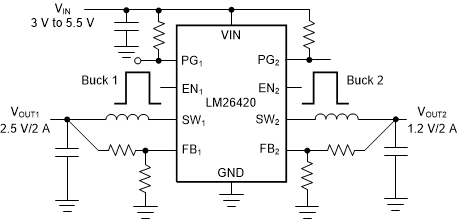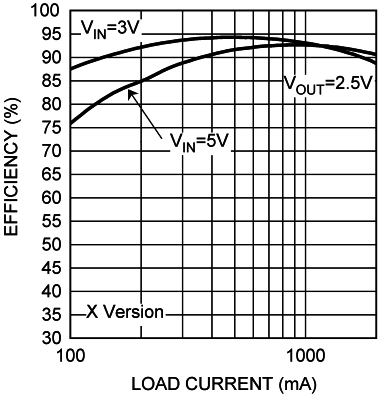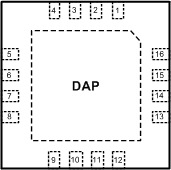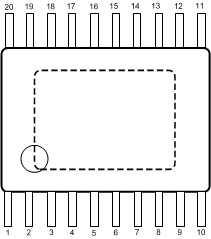-
LM26420-Q1 Dual 2A, Automotive-Qualified, High-Efficiency Synchronous DC/DC Converter
- 1
- 1 Features
- 2 Applications
- 3 Description
- 4 Pin Configuration and Functions
- 5 Specifications
- 6 Detailed Description
-
7 Application and Implementation
- 7.1 Application Information
- 7.2 Typical Applications
- 7.3 Power Supply Recommendations
- 7.4 Layout
- 8 Device and Documentation Support
- 9 Revision History
- 10Mechanical, Packaging, and Orderable Information
- IMPORTANT NOTICE
Package Options
Mechanical Data (Package|Pins)
Thermal pad, mechanical data (Package|Pins)
Orderable Information
LM26420-Q1 Dual 2A, Automotive-Qualified,
High-Efficiency Synchronous
DC/DC Converter
1 Features
- Qualified for automotive applications
- AEC Q100-qualified with the following results:
- Device temperature grade 0 (Q0): –40°C to +150°C ambient operating temperature
- Device temperature grade 1 (Q1): –40°C to +125°C ambient operating temperature
- Functional Safety-Capable
- Compliant with CISPR25 class 5 conducted emissions
- Input voltage range of 3V to 5.5V
- Output voltage range of 0.8V to 4.5V
- 2A output current per regulator
- Fixed 2.2MHz switching frequency
- 0.8V, 1.5% Internal voltage reference
- Internal soft start
- Independent power good and precision enable for each output
- Current mode, PWM operation
- Thermal shutdown
- Overvoltage protection
- Start-up into prebiased output loads
- Regulators are 180° out of phase
- Create a custom design using the LM26420-Q1 with the WEBENCH® Power Designer
3 Description
The LM26420-Q1 regulator is a monolithic, high-efficiency dual PWM step-down DC/DC converter. This device has the ability to drive two 2A loads with an internal 75mΩ MOS top switch and an internal 50mΩ MOS bottom switch using state-of-the-art BICMOS technology results in the best power density available. The world-class control circuitry allow on times as low as 30ns, thus supporting exceptionally high-frequency conversion over the entire 3V to 5.5V input operating range down to the minimum output voltage of 0.8V.
Although the operating frequency is high, efficiencies up to 93% are easy to achieve. External shutdown is included, featuring an ultra-low standby current. The LM26420-Q1 uses current-mode control and internal compensation to provide high performance regulation over a wide range of operating conditions.
Because the switching frequency is made sure to be greater than 2MHz, the LM26420-Q1 can be used in automotive applications without causing interference in the AM frequency band.
| PART NUMBER | PACKAGE(1) | PACKAGE SIZE(2) |
|---|---|---|
| LM26420-Q1 | PWP (HTSSOP, 20) | 6.5mm × 6.4mm |
| RUM (WQFN, 16) | 4mm × 4mm |
 LM26420 Dual Buck DC/DC
Converter
LM26420 Dual Buck DC/DC
Converter LM26420 Efficiency (Up to
93%)
LM26420 Efficiency (Up to
93%)4 Pin Configuration and Functions
 Figure 4-1 RUM Package16-Pin WQFNTop View
Figure 4-1 RUM Package16-Pin WQFNTop View Figure 4-2 PWP Package20-Pin HTSSOPTop View
Figure 4-2 PWP Package20-Pin HTSSOPTop View| PIN | TYPE(1) | DESCRIPTION | |
|---|---|---|---|
| NUMBER | NAME | ||
| 1,2 | VIND1 | P | Power input supply for Buck 1 |
| 3 | SW1 | P | Output switch for Buck 1. Connect to the inductor. |
| 4 | PGND1 | G | Power ground pin for Buck 1 |
| 5 | FB1 | A | Feedback pin for Buck 1. Connect to external resistor divider to set output voltage. |
| 6 | PG1 | G | Power-Good Indicator for Buck 1. Pin is connected through a resistor to an external supply (open-drain output). |
| 7 | PG2 | G | Power-Good Indicator for Buck 2. Pin is connected through a resistor to an external supply (open-drain output). |
| 8 | FB2 | A | Feedback pin for Buck 2. Connect to external resistor divider to set output voltage. |
| 9 | PGND2 | G | Power ground pin for Buck 2 |
| 10 | SW2 | P | Output switch for Buck 2. Connect to the inductor. |
| 11, 12 | VIND2 | A | Power Input supply for Buck 2 |
| 13 | EN2 | A | Enable control input. Logic high enable operation for Buck 2. Do not allow this pin to float or be greater than VIN + 0.3 V. |
| 14 | AGND | G | Signal ground pin. Place the bottom resistor of the feedback network as close as possible to pin. |
| 15 | VINC | A | Input supply for control circuitry |
| 16 | EN1 | A | Enable control input. Logic high enable operation for Buck 1. Do not allow this pin to float or be greater than VIN + 0.3 V. |
| DAP | Die Attach Pad | — | Connect to system ground for low thermal impedance and as a primary electrical GND connection. |
| PIN | TYPE(1) | DESCRIPTION | |
|---|---|---|---|
| NUMBER | NAME | ||
| 1 | VINC | A | Input supply for control circuitry |
| 2 | EN1 | A | Enable control input. Logic high enable operation for Buck 1. Do not allow this pin to float or be greater than VIN + 0.3 V. |
| 3, 4 | VIND1 | A | Power Input supply for Buck 1 |
| 5 | SW1 | P | Output switch for Buck 1. Connect to the inductor. |
| 6,7 | PGND1 | G | Power ground pin for Buck 1 |
| 8 | FB1 | A | Feedback pin for Buck 1. Connect to external resistor divider to set output voltage. |
| 9 | PG1 | G | Power Good Indicator for Buck 1. Pin is connected through a resistor to an external supply (open-drain output). |
| 10, 11, DAP | Die Attach Pad | — | Connect to system ground for low thermal impedance, but this pin cannot be used as a primary GND connection. |
| 12 | PG2 | G | Power Good Indicator for Buck 2. Pin is connected through a resistor to an external supply (open-drain output). |
| 13 | FB2 | A | Feedback pin for Buck 2. Connect to external resistor divider to set output voltage. |
| 14, 15 | PGND2 | G | Power ground pin for Buck 2 |
| 16 | SW2 | P | Output switch for Buck 2. Connect to the inductor. |
| 17, 18 | VIND2 | A | Power Input supply for Buck 2 |
| 19 | EN2 | A | Enable control input. Logic high enable operation for Buck 2. Do not allow this pin to float or be greater than VIN + 0.3 V. |
| 20 | AGND | G | Signal ground pin. Place the bottom resistor of the feedback network as close as possible to pin. |